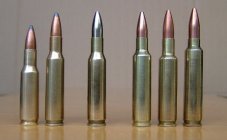I am a competition shooter, a cartridge collector, and an amateur historian, not necessarily in that order. I thought that this Forum would be a good place to share a little of my interests with you by describing a few of the competition cartridges from my collection, but also picturing them and, when appropriate, giving a little history of how they came to be. I’ll start with one that everybody knows, the 222 Remington.
In 1948 Remington introduced their new Model 722 rifles. The first “short action†Remington, it was chambered in 300 Savage and 257 Roberts and advertised as a new, lighter weight, big game rifle. But even before the first 722 found its way to gun store shelves, Remington was looking at the rifle as the foundation for a new live-varmint cartridge, something that would fill the gap between the 22 Hornet and the 220 Swift. Rather than try to modify one of the existing cartridges, Remington R&D decided to develop a completely new case. The prototype looked very much like todays 221 Fireball. It was 1.450" long and loaded with a 48-grain soft-point bullet. Different primers, powders, and powder charges were tested for velocity and accuracy. But Mike Walker, the designer of the 722 action, thought the cartridge was too short to feed reliably through the 722 action and so he recommended a slightly longer case. With the redesigned cartridge in hand, he and F&S Gun Editor Warren Page set forth to test it in the field. They found the bullet to be too hard resulting in ricochets and unreliable expansion and recommended the weight be increased to 50 grains, the jacket thinned, and the velocity increased to 3200 fps. All three changes were adopted and the new 222 Remington was introduced in early 1950.
Both Page and Walker were Benchrest shooters and saw the potential of the new cartridge for 100 and 200-yard benchrest. It was first used in competition in 1951 and started winning everything in sight, dominating for more than 20 years. But there’s not a Benchrest shooter alive who doesn’t think a good cartridge can be made better and even it was wildcatted. Shown below are six cartridges from my collection. A 222 Prototype, a standard 222 Remington varmint load, a 222 Remington Benchrest load, and three wildcats, the 222-35, 222-40, and 222 Haney.
In 1948 Remington introduced their new Model 722 rifles. The first “short action†Remington, it was chambered in 300 Savage and 257 Roberts and advertised as a new, lighter weight, big game rifle. But even before the first 722 found its way to gun store shelves, Remington was looking at the rifle as the foundation for a new live-varmint cartridge, something that would fill the gap between the 22 Hornet and the 220 Swift. Rather than try to modify one of the existing cartridges, Remington R&D decided to develop a completely new case. The prototype looked very much like todays 221 Fireball. It was 1.450" long and loaded with a 48-grain soft-point bullet. Different primers, powders, and powder charges were tested for velocity and accuracy. But Mike Walker, the designer of the 722 action, thought the cartridge was too short to feed reliably through the 722 action and so he recommended a slightly longer case. With the redesigned cartridge in hand, he and F&S Gun Editor Warren Page set forth to test it in the field. They found the bullet to be too hard resulting in ricochets and unreliable expansion and recommended the weight be increased to 50 grains, the jacket thinned, and the velocity increased to 3200 fps. All three changes were adopted and the new 222 Remington was introduced in early 1950.
Both Page and Walker were Benchrest shooters and saw the potential of the new cartridge for 100 and 200-yard benchrest. It was first used in competition in 1951 and started winning everything in sight, dominating for more than 20 years. But there’s not a Benchrest shooter alive who doesn’t think a good cartridge can be made better and even it was wildcatted. Shown below are six cartridges from my collection. A 222 Prototype, a standard 222 Remington varmint load, a 222 Remington Benchrest load, and three wildcats, the 222-35, 222-40, and 222 Haney.











